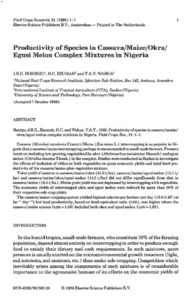| dc.contributor.author | Ikeorgu, J. |
| dc.contributor.author | Ezumah, H.C. |
| dc.contributor.author | Wahua, T.A. |
| dc.date.accessioned | 2019-12-04T11:29:49Z |
| dc.date.available | 2019-12-04T11:29:49Z |
| dc.date.issued | 1989 |
| dc.identifier.citation | Ikeorgu, J., Ezumah, H.C. & Wahua, T.A. (1989). Productivity of species in cassava/maize/okra/egusi melon complex mixtures in Nigeria. Field Crops Research, 21(1), 1-7. |
| dc.identifier.issn | 0378-4290 |
| dc.identifier.uri | https://hdl.handle.net/20.500.12478/5040 |
| dc.description.abstract | Cassava (Manihot esculenta Crantz)/Maize (Zea mays L.) intercropping is so popular in Nigeria that a cassava/maize intercropping package is recommended to small-scale farmers. Farmers insist on including low-growing vegetables like okra (Abelmoschus esculentus Moench) and egusi melon (Citrullus lanatus Thunb.) in the complex. Studies were conducted in Ibadan to investigate the effects of inclusion of either or both vegetables on gross economic yields and total land productivity of the cassava/maize-plus-vegetables mixture. Tuber yield of cassava in cassava/maize/okra (15.8 t/ha), cassava/maize/egusi melon (15.1 t/ ha) and cassava/maize/okra/egusi melon (14.5 t/ha) did not differ significantly from that in cassava/maize (16.4 t/ha). Maize grain yield was not depressed by intercropping with vegetables. The economic yields of intercropped okra and egusi melon were reduced by more than 50% of their respective sole crop yields. The cassava/maize cropping system yielded highest calories per hectare per day (18.6 × 104 cal ha−1 day−1) but land productivity, based on land equivalent ratio (ler), was higher where the cassava/maize system (ler= 1.58) included both okra and egusi melon (ler= 1.60). |
| dc.description.sponsorship | International Foundation for Science |
| dc.language.iso | en |
| dc.subject | Intercropping |
| dc.subject | Small-Scale |
| dc.subject | Farmers |
| dc.subject | Vegetables |
| dc.subject | Technology |
| dc.subject | Economics |
| dc.title | Productivity of species in cassava/maize/okra/egusi melon complex mixtures in Nigeria |
| dc.type | Journal Article |
| dc.description.version | Peer Review |
| cg.contributor.affiliation | National Root Crops Research Institute, Nigeria |
| cg.contributor.affiliation | International Institute of Tropical Agriculture |
| cg.contributor.affiliation | Rivers State University |
| cg.coverage.region | Africa |
| cg.coverage.region | West Africa |
| cg.coverage.country | Nigeria |
| cg.isijournal | ISI Journal |
| cg.authorship.types | CGIAR and developing country institute |
| cg.iitasubject | Crop Systems |
| cg.iitasubject | Smallholder Farmers |
| cg.iitasubject | Post-Harvesting Technology |
| cg.iitasubject | Socioeconomy |
| cg.accessibilitystatus | Limited Access |
| local.dspaceid | 102303 |
| cg.identifier.doi | https://doi.org/10.1016/0378-4290(89)90035-X |

